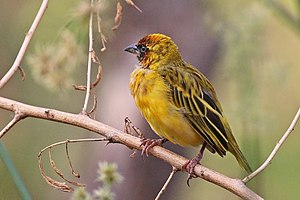Gold coat weaver
| Gold coat weaver | ||||||||||||
|---|---|---|---|---|---|---|---|---|---|---|---|---|

Golden- coat weaver ( Ploceus taeniopterus ), males in transition dress |
||||||||||||
| Systematics | ||||||||||||
|
||||||||||||
| Scientific name | ||||||||||||
| Ploceus taeniopterus | ||||||||||||
| Reichenbach , 1863 |
The gold coat weaver ( Ploceus taeniopterus ) belongs to the family of the weaver birds (Ploceidae) to the genus of the bunting weaver ( Ploceus ).
The Latin additional species comes from ancient Greek ταινια tainia , German 'band' and ancient Greek πτερόν pteron , German 'wing' .
The bird is found in East Africa in Ethiopia , the Democratic Republic of the Congo , Kenya , Sudan (where it is considered very common) and Uganda . Lately mostly on the shores of Lake Baringo .
The distribution area includes habitats with tall grass and isolated acacias , along larger rivers and in swamps .
features
The species is 13 cm tall and weighs between 20 and 27 g. The male has dark brown irises in the breeding plumage and a black face mask from directly behind the eyes down to the chest above, which is broadly framed in dark chestnut brown on the forehead. The combination of a dark eye and a black mask reaching up to the chest is characteristic.
In the plain dress, males and females have dark eyes, a yellow stripe above the eyes and a yellow -brown breast. The top is brown and the beak is darker than that of the female yolk weaver . Fledglings are pinnate similar to the female, but with white eyes and resemble the Cabanis weaver young.
The species is monotypical .
It seems to hybridize with the shoulder patch weaver ( Ploceus badius ) in Sudan .
voice
The male's singing is described as hesitant and jerky with a dry and unmusical ending.
Way of life
The diet consists mainly of plant seeds , but also insects .
The breeding season is between August and October in Sudan, between July and November in the Democratic Republic of the Congo and between May and September in Kenya.
Gold-mantled weavers are polygynous , breed in small colonies . The clutch consists of 2 - 3 greenish to brownish eggs, which are hatched by the female.
Hazardous situation
The stock is not considered to be at risk ( least concern ).
literature
- HGL Reichenbach: Die Singvögel, 1863, p. 78, Biodiversity Library
Web links
- Videos, photos and sound recordings of Ploceus taeniopterus in the Internet Bird Collection
- Weaver Watch
Individual evidence
- ↑ Goldmantelweber , in Avibase - The World Bird Database
- ^ JA Jobling: A Dictionary of Scientific Bird Names. Oxford University Press. 1991. ISBN 0-19-854634-3 .
- ↑ a b c d Handbook of the Birds of the World
- ^ A b c T. Stevenson, J. Fanshawe: Birds of East Africa. Kenya, Tanzania, Uganda, Rwanda, and Burundi. Princeton University Press, 2002, ISBN 978-0-691-12665-4 .
- ↑ Old World sparrows, snowfinches, weavers
- ↑ R. Demey: Recent reports. In: Bulletins of the African Bird Club Vol. 21, No. 2, pp. 239-252, 2014
- ↑ Redlist
